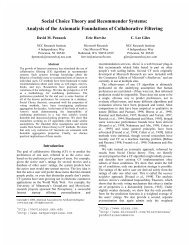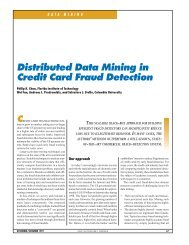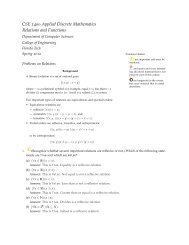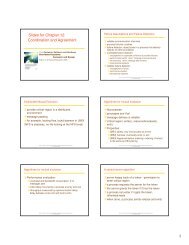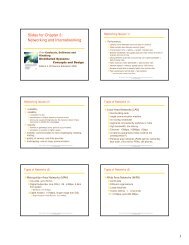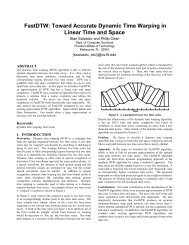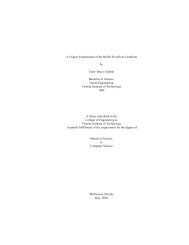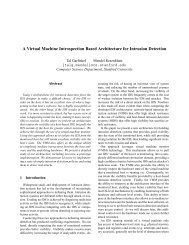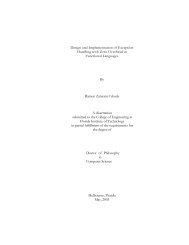Quick Sort Algorithm - Florida Institute of Technology
Quick Sort Algorithm - Florida Institute of Technology
Quick Sort Algorithm - Florida Institute of Technology
You also want an ePaper? Increase the reach of your titles
YUMPU automatically turns print PDFs into web optimized ePapers that Google loves.
<strong>Quick</strong> <strong>Sort</strong> <strong>Algorithm</strong>Song QinDept. <strong>of</strong> Computer Sciences<strong>Florida</strong> <strong>Institute</strong> <strong>of</strong> <strong>Technology</strong>Melbourne, FL 32901ABSTRACTGiven an array with n elements, we want to rearrange them inascending order. In this paper, we introduce <strong>Quick</strong> <strong>Sort</strong>, adivide-and-conquer algorithm to sort an N element array. Weevaluate the O(NlogN) time complexity in best case and O(N 2 )in worst case theoretically. We also introduce a way to approachthe best case.1. INTRODUCTIONSearch engine relies on sorting algorithm very much. When yousearch some key word online, the feedback information isbrought to you sorted by the importance <strong>of</strong> the web page.Bubble, Selection and Insertion <strong>Sort</strong>, they all have an O(N 2 )time complexity that limits its usefulness to small number <strong>of</strong>element no more than a few thousand data points.The quadratic time complexity <strong>of</strong> existing algorithms such asBubble, Selection and Insertion <strong>Sort</strong> limits their performancewhen array size increases. Merge <strong>Sort</strong> needs more memory tocreate new arrays.In this paper we introduce <strong>Quick</strong> <strong>Sort</strong>. It is accomplished bydividing the array into two partitions and then sorting eachpartition recursively.Our main contribution is the introduction <strong>of</strong> a O(NlogN) sortingalgorithm.The next section describes some existing sorting algorithms:Bubble <strong>Sort</strong>, Insertion <strong>Sort</strong>, Selection <strong>Sort</strong> and Merge <strong>Sort</strong>.Section 3 provides a details explanation <strong>of</strong> our Merge <strong>Sort</strong>algorithm. Section 4 and 5 discusses empirical and theoreticalevaluation based on efficiency. Section 6 summarizes our studyand gives a conclusion.each iteration. Repeat this on the rest <strong>of</strong> the unsorted regionwithout the first element.Bubble sort works as follows: keep passing through the list,exchanging adjacent element, if the list is out <strong>of</strong> order; when noexchanges are required on some pass, the list is sorted.Merge sort [4]has a O(NlogN) time complexity. It divides thearray into two subarrays each with N/2 items. Conquer eachsubarray by sorting it. Unless the array is sufficiently small(oneelement left), use recursion to do this. Combine the solutions tothe subarrays by merging them into single sorted array.In Bubble sort, Selection sort and Insertion sort, the O(N 2 ) timecomplexity limits the performance when N gets very big.Although Merge <strong>Sort</strong> has the O(NlogN) time complexity, itneeds more memory to create new arrays. Our algorithm willsolve this problem and also approach a O(NlogN) timecomplexity.3. APPROACH<strong>Quick</strong> sort uses a divide-and-conquer approach. It isaccomplished by dividing the array into two partitions and thensorting each partition recursively. In <strong>Quick</strong>sort, the array ispartitioned by placing all items smaller than some pivot itembefore that item and all items larger than the pivot item after it.See figure 1. After each partition, the pivot item is in the rightplace. Also, each partition is decreasing. We can guarantee thatuntil there is one element in partition, we will have a sortedarray.6 5 1 3Pivot Item2 4Note: Arrays we mentioned in this article have the size <strong>of</strong> N.2 136 5 42. RELATED WORKSelection sort [1] works as follows: At each iteration, weidentify two regions, sorted region (no element from start) andunsorted region. We “select” one smallest element from theunsorted region and put it in the sorted region. The number <strong>of</strong>elements in sorted region will increase by 1 each iteration.Repeat this on the rest <strong>of</strong> the unsorted region until it isexhausted. This method is called selection sort because it worksby repeatedly “selecting” the smallest remaining element.Figure 1.PartitionProblem: <strong>Sort</strong> Array a <strong>of</strong> N elements in ascending orderInput: Array a, index <strong>of</strong> first array element lo and last arrayelement hiOutput: Array a in ascending orderWe <strong>of</strong>ten use Insertion <strong>Sort</strong> [2] to sort bridge hands: At eachiteration, we identify two regions, sorted region (one elementfrom start which is the smallest) and unsorted region. We takeone element from the unsorted region and “insert” it in thesorted region. The elements in sorted region will increase by 1
1|void quicksort (int[] a, int lo, int hi)2|{3| int i=lo, j=hi, h;4| int x=a[k];// partition5| do6| {7| while (a[i]x) j--;9| if (i
6 5 1 26|8 3 6 4 9 5 71|2|3|4|5|<strong>Sort</strong>ed11<strong>Sort</strong>ed<strong>Sort</strong>ed16 5 1 2<strong>Sort</strong>ed1Pivot ItemPivot Item222<strong>Sort</strong>edPivot Item6 5 25556<strong>Sort</strong>ed6<strong>Sort</strong>ed67| 8 3 6 4 9 5 78|9|10|11|<strong>Sort</strong>ed3<strong>Sort</strong>ed3Pivot Item5 3 43<strong>Sort</strong>ed6Pivot Item <strong>Sort</strong>edFigure 4.Best Case <strong>of</strong> <strong>Quick</strong>sort9 8 7<strong>Sort</strong>ed5 4 6 7 8 9sorted4Pivot Item455<strong>Sort</strong>ed6<strong>Sort</strong>ed6<strong>Sort</strong>ed7Pivot ItemPivot Item<strong>Sort</strong>ed87 8 99Figure 3.Worst Case <strong>of</strong> <strong>Quick</strong>sortThe worst case <strong>of</strong> quick sort occur when we choose the smallestor the largest element as the pivot. It needs the mostcomparisons in each iteration. See figure 3, we want to sorta=[6,5,1,2] . From line1 to 2, the smallest item 1 is chosen as thepivot. All elements need to compare with the pivot item once.From line 2 to 3, the largest item 6 is chosen as the pivot. Allelements need to compare with the pivot item once. From line 3to 4, 1 comparison is needed.Let T(N) be the number <strong>of</strong> comparison needed to sort an array<strong>of</strong> N elements.In the worst case, we need N-1 comparisons in the first round.Then we need T(N-1) comparisons to sort N-1 elements.TNN‐1TN‐11We need 0 time to sort 1 element:T102The best case <strong>of</strong> quicksort occurs when we choose median as thepivot item each iteration. Figure 4 shows a example <strong>of</strong> the bestcase <strong>of</strong> <strong>Quick</strong>sort. Each partition decreases by almost half thearray size each iteration. From line 7 to line8, after 6 timescomparison, 6 is in the right place and we get partition {5,3,4}and {9,8,7}. It is the same with line 8-9. Line 10, when there aretwo elements left, the array is sorted.Let T(N) be the number <strong>of</strong> comparison needed to sort an array<strong>of</strong> N elements. In the best case, we need N-1 comparisons tosort the pivot in the first iteration. We need T((N-1)/2)comparisons to sort each two partition.T(N)=N-1 + 2T((N-1)/2) [1]We need 0 comparisons to sort 1 element.T(1)=0 [2]TN‐1N‐2TN‐2TN‐2N‐3TN‐3…TN‐N‐1N‐N‐1TN‐N‐11T01T(N)=(N-1)+T(N-1)=(N-1)+(N-2)+ TN‐2(N-1)+(N-2)+(N-3)+ TN‐3(N-1)+(N-2)+(N-3)+…+T(N-(N-1))=(N-1)+(N-2)+(N-3)+…+1=(N 2 +N)/2=O(N 2 )Thus, we have a O(N 2 ) time complexity in the worst case.345T((N-1)/2)=2T((N-3)/4)+(N-1)/2-1 [3]Equation [3] replacing T((N-1)/2)) in equation [1] yieldsT(N)=2[(2T((N-3)/4)+(N-1)/2-1)]+N-1=2 2 T((N-3)/2 2 )+N-3+N-1 [4]T((N-3)/2 2 )=2T((N-7)/2 3 )+(N-3)/4-1 [5]Equation [5] replacing T((N-3)/2 2 ) in equation [4] yieldsT(N)=2 3 T((N-7)/2 3 )+N-7+N-3+N-1 [6]T(N)=2 k T(N-1+N-3+N-7+…+N-(2 k -1))5.Empirical EvaluationThe efficiency <strong>of</strong> the <strong>Quick</strong>sort algorithm will be measured inCPU time which is measured using the system clock on amachine with minimal background processes running, withrespect to the size <strong>of</strong> the input array, and compared to theMergesort algorithm. <strong>Quick</strong> sort algorithm will be run with thearray size parameter set to: 1k, 2k,…10k. To ensurereproducibility, all datasets and algorithms used in this
evaluation can be found at“http://cs.fit.edu/~pkc/pub/classes/writing/httpdJan24.log.zip”.The datasets used are synthetic data and real-life data sets <strong>of</strong>varying-length arrays with random numbers. The tests were runon PC running Windows XP and the following specifications:Intel Core 2 Duo CPU E8400 at 1.66 GHz with 2 GB <strong>of</strong> RAM.<strong>Algorithm</strong>s are run in lisp.5.1 ProceduresThe procedure is as follows:1 Store 10,000 records in an array2 Choose 10,000 records3 <strong>Sort</strong> records using merge sort and quick sort algorithm 10times4 Record average CPU time5 Increment Array size by 10,000 each time until reach10,000, repeat 3-55.2 Results and AnalysisFigure 5 shows <strong>Quick</strong> <strong>Sort</strong> algorithm is significantly faster(about 3 times faster) than Merge <strong>Sort</strong> algorithm for array sizefrom 4k to 10k and less faster(about 1 time) when array size isless than 3k. All in all, quicksort beats mergesort all the cases.CPU Time(second)By passing the regular significant test, we found that differencebetween merge and quick sort when k=9 is statisticallysignificant with array size from 4k to 10k with 95% confident.(t=2.26, d.f.=9, p
quicksort in all cases in our datasets range. By passingsignificant test, we show that quicksort is significant faster thanmergesort when N is greater than 4000. By passing anothersignificant test, we show that when k=9, quicksort is significantfaster than when k=3 and 27.One <strong>of</strong> the limitations is that in order to approach the best casethe algorithm consumes much time on finding the median. Howto find exactly the median in less time may needs future work.REFERENCES.[1] Sedgewick, <strong>Algorithm</strong>s in C++, pp.96-98, 102, ISBN 0-201-51059-6 ,Addison-Wesley , 1992[2] Sedgewick, <strong>Algorithm</strong>s in C++, pp.98-100, ISBN 0-201-51059-6 ,Addison-Wesley , 1992[3] Sedgewick, <strong>Algorithm</strong>s in C++, pp.100-104, ISBN 0-201-51059-6 ,Addison-Wesley , 1992[4] Richard Neapolitan and Kumarss Naimipour, pp.52-58.1992[5] C.A.R. Hoare: <strong>Quick</strong>sort. Computer Journal, Vol. 5, 1, 10-15(1962)


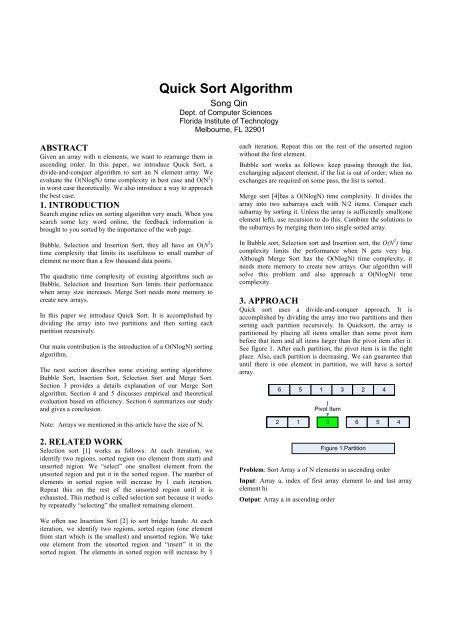
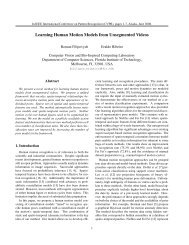
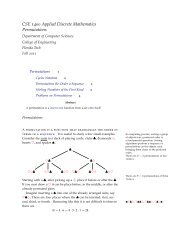
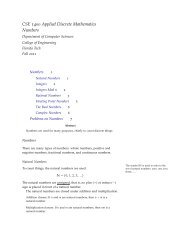
![{ public static void main (String[] args) { System.out.println (](https://img.yumpu.com/49719541/1/190x143/-public-static-void-main-string-args-systemoutprintln-hello-.jpg?quality=85)
